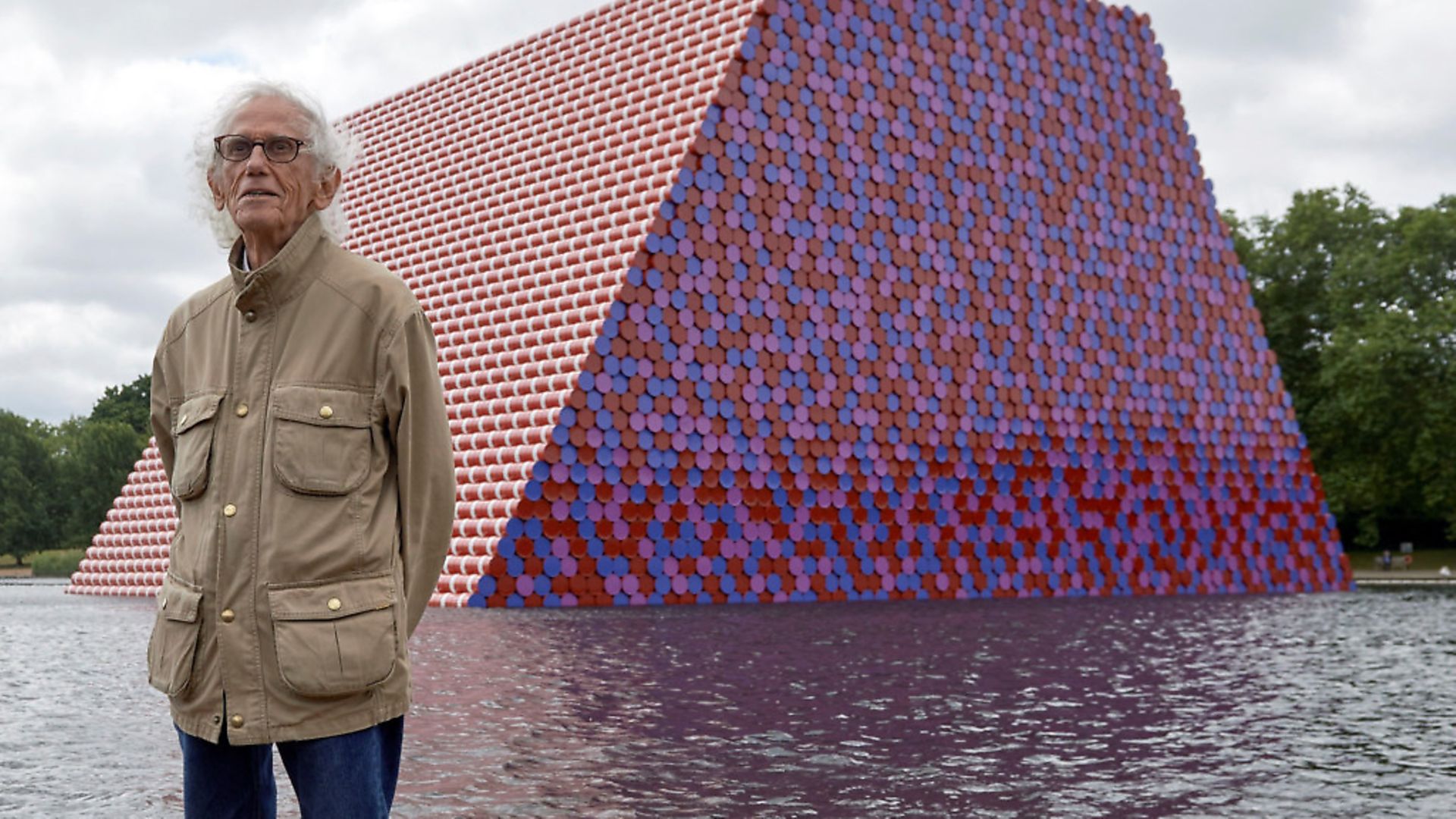
In the week of the death of Bulgarian artist Christo, WILL SELF explores the famous works of a man who preferred to leave nothing behind.
So farewell then to Christo, the Bulgarian-born artist who has died aged 84, and who, together with his French wife Jeanne-Claude Denat de Guillebon (who predeceased him in 2010), produced some of the largest and most extravagantly silly artworks the world has ever seen. Beginning humbly in Cologne, in 1968, by wrapping up a few barrels on the quayside, the couple just kept on with their couverture, encasing an entire bay on the coast of New South Wales in the 1969, the Pont Neuf in Paris in 1985, and eventually the Reichstag in Berlin in 1995, only six years after the fall of the Wall. Two years ago Christo at last came to my hometown, accompanied by 7,506 of his by now ‘signature’ plastic barrels. These ones he stacked up into a bizarre sort of tetrahedron shape, which he called Mastaba, and sited in the middle of the Serpentine in Hyde Park.
I often cycle that way en route to Paddington Station, so throughout the summer of 2018 I had ample opportunities to meditate on Christo and De Guillebon’s oeuvre. In their favour was the ephemerality of their practice – Christo wished, unlike most other artists and architects, to leave nothing behind: the works were temporary follies, intended to make those who witnessed them feel a giddy sort of joy at such playfulness. Fair enough – and welcome contrast to the wilful portentousness of the so-called ‘land-artists’ of the 1960s and 1970s, whose works, by contrast, enacted an arid and aestheticised form of giganticism. Also in the wrap-artist’s favour was the non-commercial nature of the works – they never accepted any corporate sponsorship, preferring to fund their projects by selling their plans for them.
But despite their ephemerality and their seeming liberality, there remains something altogether bounded about the Christo-De Guillebon vision. To paraphrase Shelley: ‘Two vast and trunkless legs of stone / Stand in the desert… near them on the sand lies a enormous piece of cloth that once clad them.’ By which I mean to express the idea that while the wrapping may have been discarded, the objects that gave that wrapping any salience remain – and it’s these that, for the most part made the works at all significant. Mastaba is of course entirely gone – but if I think back to the weird interlude when a giant ziggurat of barrels dominated this boating lake, all I recall is that it was created by the same man who wrapped up the Reichstag. The artwork itself did have a considerable aura – but that resided in this improbability: its juxtaposition with the topography of a landscaped English park; Mastaba looked like a desktop toy of some sort, writ impossibly huge.
And it’s here, in their distortions of scale that the meanings of Christo and De Guillebon’s works really reside. Such changes always deprive us of the sensual aspects of an object – while making them more intelligible: a scale map allows us to orient ourselves within a landscape, but we can’t feel the ache in our thighs from climbing a steep hill when we simply run our eye over some contour lines. By wrapping up the Reichstag, Christo and De Guillebon made a gift of this very large building – and in so doing showed what? That democracy is itself ephemeral? That all things must pass? Or quite possibly that the German parliament was itself a commodity – in the Marxist sense – and thereby capable of being fetishised: having our own distorted picture of human relationships of production and exchange projected on to its rippling flanks.
Of course, all such ‘interpretations’ are wilfully tendentious – and for that reason they’re resisted by not just by the wrappers, but all self-respecting artists. Self-respecting – and money-earning – because without the mystique conferred by the alleged difficulty of their interpretation, works like Mastaba (if you’ll forgive the procrustean pun) just look like a load of w**k. Which is not to say a load of w**k is necessarily a bad thing – for it, too, can be joyful (if necessarily ephemeral). But this load-of-w**k problem doesn’t just relate to Christo and De Guillebon’s work – arguably it’s present in a whole posse of late 20th and early 21st century artists who make distortions in scale central to their method. Damien Hirst and Antony Gormley follow in the giant footsteps of Claes Oldenburg – who in turn dogged those of Marcel Duchamp.
The latter is famous for Fountain, a men’s urinal exhibited as an artwork – but really, Duchamp’s most acute piece of arty-subversion was his Boîte-en-Valise (Box-in-a-Suitcase), which took the form of a travelling salesman’s sample case from the interwar period, but which contained (in various iterations) miniatures of all of Duchamp’s own works. The wall-mounted pissoir certainly took the piss effectively out of the way the gallery creates the artwork rather than the artist – but the Boîte shows that aesthetics themselves can be repackaged, such that one era’s great artworks look like mere trinkets to those of the next.










